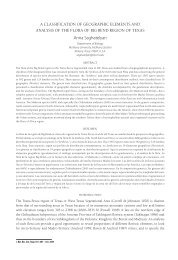George Poinar Jr. Kenton L. Chambers Ron Buckley
George Poinar Jr. Kenton L. Chambers Ron Buckley
George Poinar Jr. Kenton L. Chambers Ron Buckley
Create successful ePaper yourself
Turn your PDF publications into a flip-book with our unique Google optimized e-Paper software.
94 Journal of the Botanical Research Institute of Texas 1(1)<br />
Fig. 2. Flower of Eoëpigynia burmensis in Burmese amber. Anther on right as described in Fig. 1C. Scale bar = 0.34 mm.<br />
The generic makeup of Cornales, as well as family Cornaceae, has been reexamined in recent molecular<br />
phylogenetic studies (Xiang et al. 1998; Fan & Xiang 2003; Hilu et al. 2003; Judd & Olmstead 2004). It is<br />
proposed that Cornaceae be limited to two genera, Cornus and Alangium, and that other genera formerly<br />
assigned here be segregated to families Nyssaceae, Mastixiaceae, and Grubbiaceae. At the ordinal level, the<br />
once widely separated families Loasaceae and Hydrangeaceae are to be included in Cornales. If Eoëpigynia is<br />
placed in the larger context of this basal asterid clade, it shows that a simplified epigynous flower, with a single<br />
style, 4-merous perianth parts, and four stamens, arose early in the differentiation of this evolutionary line.<br />
As pointed out by Gustafsson and Albert (1999), epigyny is not a recent phenomenon. Examples were<br />
found by Friis et al. (1994) in Early Cretaceous sediments in Portugal, originally dated as Valanginian or<br />
Hauterivian but now reassigned to the early Albian (Heimhofer et al. 2005). A probable relationship to<br />
Chloranthaceae has been established (Eklund et al. 2004). Phylogenetic studies have also shown that the<br />
evolution of ovary position has been dynamic, with at least 64 changes from hypogyny to epigyny but only<br />
24 changes in the opposite direction (Gustafsson & Albert 1999; Soltis et al. 2003). In neither of these papers<br />
are Cornales specifically discussed, however. Modern Cornales are well represented in the Southeast Asian<br />
flora, with Cornus itself having a circumpolar Northern Hemisphere distribution (Wangerin 1910; Xiang<br />
et al. 2005). Reference fossils (fruit stones) attributed to the Cornelian-Cherry line of Cornus in the latter<br />
paper are taken from the careful review by Eyde (1988) and are Eocene or younger in age.<br />
In studies using molecular phylogenetic dating methods with known fossil reference points (Bremer et<br />
al. 2004; Anderson et al. 2005), the Early Coniacian (88 mybp) cornalean genus Hironoia (Takahashi et al.<br />
2002) has been used. Based on these papers, the age of the stem group asterids may be ca. 128 mybp, the<br />
Cornales and Ericales diverging soon afterwards (Stevens 2001 onwards). Anderson et al. (2005) place the<br />
separation of Cornales from remaining asterids at ca. 109 mybp. The reference fossil Hironoia consists of



